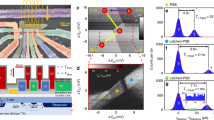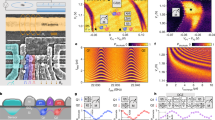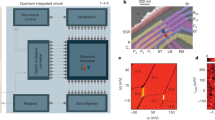Abstract
The spin of an electron or a nucleus in a semiconductor1 naturally implements the unit of quantum information—the qubit. In addition, because semiconductors are currently used in the electronics industry, developing qubits in semiconductors would be a promising route to realize scalable quantum information devices2. The solid-state environment, however, may provide deleterious interactions between the qubit and the nuclear spins of surrounding atoms3, or charge and spin fluctuations arising from defects in oxides and interfaces4. For materials such as silicon, enrichment of the spin-zero 28Si isotope drastically reduces spin-bath decoherence5. Experiments on bulk spin ensembles in 28Si crystals have indeed demonstrated extraordinary coherence times6,7,8. However, it remained unclear whether these would persist at the single-spin level, in gated nanostructures near amorphous interfaces. Here, we present the coherent operation of individual 31P electron and nuclear spin qubits in a top-gated nanostructure, fabricated on an isotopically engineered 28Si substrate. The 31P nuclear spin sets the new benchmark coherence time (>30 s with Carr–Purcell–Meiboom–Gill (CPMG) sequence) of any single qubit in the solid state and reaches >99.99% control fidelity. The electron spin CPMG coherence time exceeds 0.5 s, and detailed noise spectroscopy9 indicates that—contrary to widespread belief—it is not limited by the proximity to an interface. Instead, decoherence is probably dominated by thermal and magnetic noise external to the device, and is thus amenable to further improvement.
This is a preview of subscription content, access via your institution
Access options
Subscribe to this journal
Receive 12 print issues and online access
$259.00 per year
only $21.58 per issue
Buy this article
- Purchase on Springer Link
- Instant access to full article PDF
Prices may be subject to local taxes which are calculated during checkout




Similar content being viewed by others
References
Awschalom, D. D., Bassett, L. C., Dzurak, A. S., Hu, E. L. & Petta, J. R. Quantum spintronics: engineering and manipulating atom-like spins in semiconductors. Science 339, 1174–1179 (2013).
Zwanenburg, F. A. et al. Silicon quantum electronics. Rev. Mod. Phys. 85, 961–1019 (2013).
Yao, W., Liu, R-B. & Sham, L. Theory of electron spin decoherence by interacting nuclear spins in a quantum dot. Phys. Rev. B 74, 195301 (2006).
De Sousa, R. Dangling-bond spin relaxation and magnetic 1/f noise from the amorphous-semiconductor/oxide interface: theory. Phys. Rev. B 76, 245306 (2007).
Witzel, W. M., Carroll, M. S., Morello, A., Cywinski, L. & Das Sarma, S. Electron spin decoherence in isotope-enriched silicon. Phys. Rev. Lett. 105, 187602 (2010).
Tyryshkin, A. M. et al. Electron spin coherence exceeding seconds in high-purity silicon. Nature Mater. 11, 143–147 (2012).
Steger, M. et al. Quantum information storage for over 180 s using donor spins in a 28Si ‘semiconductor vacuum’. Science 336, 1280–1283 (2012).
Saeedi, K. et al. Room-temperature quantum bit storage exceeding 39 minutes using ionized donors in silicon-28. Science 342, 830–833 (2013).
Alvarez, G. A. & Suter, D. Measuring the spectrum of colored noise by dynamical decoupling. Phys. Rev. Lett. 107, 230501 (2011).
Schenkel, T. et al. Electrical activation and electron spin coherence of ultralow dose antimony implants in silicon. Appl. Phys. Lett. 88, 112101 (2006).
Paik, S-Y., Lee, S-Y., Baker, W., McCamey, D. & Boehme, C. t1 and t2 spin relaxation time limitations of phosphorous donor electrons near crystalline silicon to silicon dioxide interface defects. Phys. Rev. B 81, 075214 (2010).
Wolfowicz, G. et al. Atomic clock transitions in silicon-based spin qubits. Nature Nanotech. 8, 561–564 (2013).
Laird, E. A., Pei, F. & Kouwenhoven, L. A valley-spin qubit in a carbon nanotube. Nature Nanotech. 8, 565–568 (2013).
Mohiyaddin, F. A. et al. Noninvasive spatial metrology of single-atom devices. Nano Lett. 13, 1903–1909 (2013).
Rahman, R., Park, S. H., Boykin, T. B., Klimeck, G., Rogge, S. & Hollenberg, L. C. L. Gate-induced g-factor control and dimensional transition for donors in multivalley semiconductors. Phys. Rev. B 80, 155301 (2009).
Greenland, P. et al. Coherent control of Rydberg states in silicon. Nature 465, 1057–1061 (2010).
Morello, A. et al. Single-shot readout of an electron spin in silicon. Nature 467, 687–691 (2010).
Dehollain, J. P., Pla, J. J., Siew, E., Tan, K. Y., Dzurak, A. S. & Morello, A. Nanoscale broadband transmission lines for spin qubit control. Nanotechnology 24, 015202 (2013).
Jamieson, D. N. et al. Controlled shallow single-ion implantation in silicon using an active substrate for sub-20-keV ions. Appl. Phys. Lett. 86, 202101 (2005).
Pla, J. J. et al. High-fidelity readout and control of a nuclear spin qubit in silicon. Nature 496, 334–338 (2013).
Pla, J. J. et al. A single-atom electron spin qubit in silicon. Nature 489, 541–545 (2012).
Balasubramanian, G. et al. Ultralong spin coherence time in isotopically engineered diamond. Nature Mater. 8, 383–387 (2009).
Maurer, P. C. et al. Room-temperature quantum bit memory exceeding one second. Science 336, 1283–1286 (2012).
Morton, J. J. L et al. Measuring errors in single-qubit rotations by pulsed electron paramagnetic resonance. Phys. Rev. A 71, 012332 (2005).
Cywinski, L., Lutchyn, R. M., Nave, C. P. & Das Sarma, S. How to enhance dephasing time in superconducting qubits. Phys. Rev. B 77, 174509 (2008).
Bylander, J. et al. Noise spectroscopy through dynamical decoupling with a superconducting flux qubit. Nature Phys. 7, 565–570 (2011).
Taylor, J. et al. High-sensitivity diamond magnetometer with nanoscale resolution. Nature Phys. 4, 810–816 (2008).
Medford, J. et al. Scaling of dynamical decoupling for spin qubits. Phys. Rev. Lett. 108, 086802 (2012).
Kalra, R., Laucht, A., Hill, C. D. & Morello, A. Robust two-qubit gates for donors in silicon controlled by hyperfine interactions. Phys. Rev. X 4, 021044 (2014).
Hu, X., Liu, Y-X. & Nori, F. Strong coupling of a spin qubit to a superconducting stripline cavity. Phys. Rev. B 86, 035314 (2012).
Acknowledgements
The authors thank M.J. Biercuk for discussions. This research was funded by the Australian Research Council Centre of Excellence for Quantum Computation and Communication Technology (project no. CE11E0001027) and the US Army Research Office (W911NF-13-1-0024). The authors acknowledge support from the Australian National Fabrication Facility and from the laboratory of Robert Elliman at the Australian National University for ion implantation facilities. The work at Keio has been supported in part by FIRST, the Core-to-Core Program by JSPS and the Grant-in-Aid for Scientific Research and Project for Developing Innovation Systems by MEXT.
Author information
Authors and Affiliations
Contributions
J.T.M., J.P.D., A.S.D. and A.M. designed the experiments. J.T.M., J.P.D. and A.L. performed the measurements and analysed the results with A.M.'s supervision. D.N.J. and J.C.M. designed the P implantation experiments. F.E.H. fabricated the device with A.S.D.'s supervision and R.K.'s assistance. T.S. and K.M.I. prepared and supplied the 28Si epilayer wafer. J.T.M., J.P.D and A.M. wrote the manuscript, with input from all co-authors.
Corresponding authors
Ethics declarations
Competing interests
The authors declare no competing financial interests.
Supplementary information
Supplementary information
Supplementary Information (PDF 1066 kb)
Rights and permissions
About this article
Cite this article
Muhonen, J., Dehollain, J., Laucht, A. et al. Storing quantum information for 30 seconds in a nanoelectronic device. Nature Nanotech 9, 986–991 (2014). https://doi.org/10.1038/nnano.2014.211
Received:
Accepted:
Published:
Issue Date:
DOI: https://doi.org/10.1038/nnano.2014.211
This article is cited by
-
Navigating the 16-dimensional Hilbert space of a high-spin donor qudit with electric and magnetic fields
Nature Communications (2024)
-
Electron charge qubit with 0.1 millisecond coherence time
Nature Physics (2024)
-
Observation of blue shift phenomena in semiconducting ZnS nanomaterials upon Ni dopant showing enhanced dielectric behavior
Indian Journal of Physics (2024)
-
Long-lived electronic spin qubits in single-walled carbon nanotubes
Nature Communications (2023)
-
Single-electron spin resonance detection by microwave photon counting
Nature (2023)



